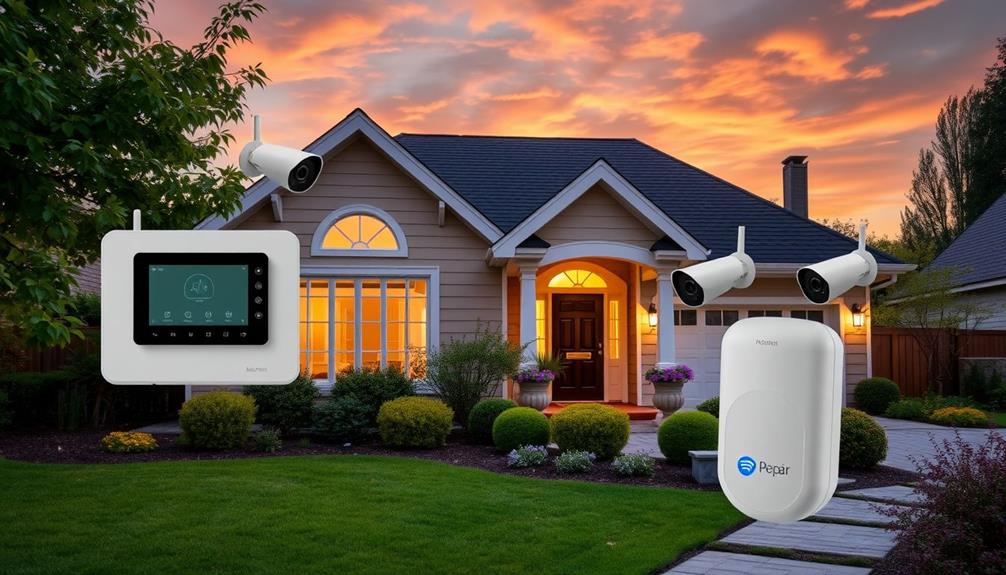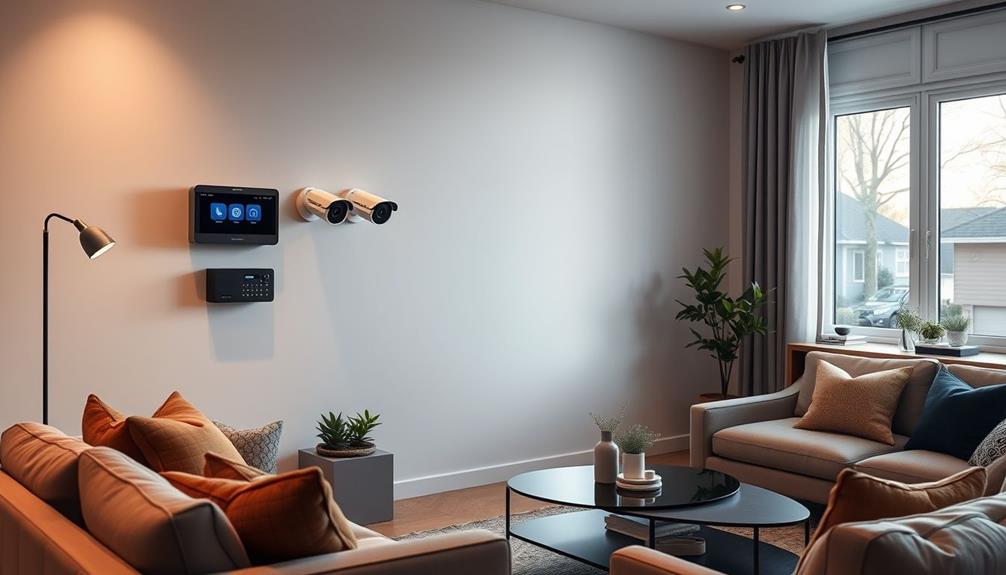Home security systems generally cost you between $10 and $60 per month, depending on the type of monitoring you choose. If you prefer self-monitoring, you can find options starting as low as $4.99 per month. Professional monitoring tends to range from $22 to $50 monthly, with additional features sometimes increasing costs. DIY systems can also save you money on installation fees. Remember that your equipment choices and features will impact the overall price as well. Keep looking, and you'll discover tips to help you find the best deal and understand all your options. Additionally, don’t forget to factor in upfront expenses for equipment, as this can significantly raise the initial cost of home security systems. Some providers offer financing or rental options, which may help ease the burden of large upfront payments. Ultimately, the cost of home security systems varies widely based on your specific needs, so it’s worth taking the time to compare plans and features before making a decision.
Key Takeaways
- Average monthly monitoring costs range from $22 to $35 for professional services, while self-monitoring options can start as low as $4.99/month.
- Professional monitoring fees typically fall between $22 and $50/month, with some companies charging up to $60/month for premium services.
- Self-monitoring systems generally average around $10/month, providing a budget-friendly alternative to professional monitoring.
- Premium equipment and additional features can increase monthly fees by $10 to $30, impacting overall security costs.
Average Monthly Costs Overview
When considering a home security system, you'll find that average monthly monitoring costs typically range from $22 to $35, depending on whether you choose self-monitoring or professional services.
If you're leaning towards self-monitoring, you can find options as low as $4.99/month with providers like Ring, or even $6.99/month with Abode. These options give you control over your security but lack the immediate response of professional monitoring.
However, if you prefer peace of mind and quicker response times, professional monitoring might be the way to go. Companies like Ring offer professional plans that range between $10 to $20/month, while Vivint's costs can be higher, typically falling between $40 to $60/month.
For more extensive systems, such as Frontpoint, expect to pay up to $49.99/month for professional monitoring.
It's essential to weigh these average monthly costs against the level of security and convenience you desire.
Whether you opt for self-monitoring or professional monitoring, understanding these monthly monitoring fees can help you make an informed decision that fits your budget and safety needs.
Factors Influencing Monthly Prices

Several factors can influence the monthly prices of home security systems, including the type of monitoring service, equipment choices, and additional features. Understanding these elements can help you make an informed decision when selecting a system that fits your budget.
| Factor | Cost Range |
|---|---|
| Self-Monitoring Fees | $4.99 – $20 |
| Professional Monitoring | $22 – $50 |
| Premium Equipment | $10 – $30 |
| Additional Features | Varies based on service |
Monthly fees can vary considerably based on whether you choose self-monitoring or professional monitoring. For example, self-monitoring options, like those from Ring, start at just $4.99, while professional services can range from $22 to $50, with companies like ADT charging around $45.99 for basic packages.
Your choice of equipment also impacts monitoring costs; premium services with smart home integration often come with higher monthly fees. Finally, don't forget about additional features like video storage or environmental monitoring, which can add to your total monthly expenses. By evaluating these factors, you can find a home security system that meets your needs and budget.
Installation Options and Fees

When considering your home security system, you've got a couple of installation options that can impact your budget.
You can opt for DIY installation to save money or hire professionals, which typically comes with fees that vary by provider.
Don't forget to factor in activation fees, as they can affect your overall costs too.
DIY Installation Savings
DIY installation of home security systems offers significant savings, with costs often ranging from $0 to $299, allowing you to skip expensive professional fees.
Many popular brands, like Ring and SimpliSafe, provide user-friendly self-installation options that help you save money right from the start. While professional installation may average around $150, opting for a DIY setup means you can customize your security system without incurring those additional costs.
In many cases, self-installed systems come with minimal activation fees, typically between $79 and $99, which can even be waived if you subscribe to their monitoring services.
Plus, you can expect to pay much lower monthly monitoring fees for DIY systems. Self-monitoring options usually average around $10, whereas professional monitoring can range from $22 to $60.
Professional Installation Costs
Professional installation costs for home security systems can vary widely, typically falling between $100 and $400 based on the provider and the complexity of your setup.
For instance, popular brands like Abode charge around $99 for installation fees, while SimpliSafe can range from $124.99 to $254.97. Vivint's fees fall between $49 and $199, making it a competitive option.
However, some companies, such as Brinks and Vivint, may offer free installation as part of their service packages, which can greatly reduce your initial system costs.
If you opt for a wired system, be prepared for a hefty price hike, as installation costs can soar to between $800 and $1,600 due to the labor-intensive nature of the setup.
On the other hand, DIY systems present a cost-effective alternative, as they typically don't incur installation fees at all.
Ultimately, when choosing a home security system, consider your budget for professional installation costs and weigh them against the convenience and expertise that professional services provide.
Activation Fee Considerations
Considering installation options, activation fees play a significant role in the overall cost of home security systems and can vary greatly among different providers. Typically, activation fees can range from $0 to $230.
If you choose professional installation, be aware that these fees might be higher, although some providers may waive them if you sign up for certain monitoring plans.
On the other hand, DIY systems often feature lower or even no activation fees, starting as low as $79, making them an attractive option for budget-conscious consumers.
For monitored systems, the activation fee is often included in the total package price. However, if you opt for unmonitored systems, you might need to pay upfront for equipment and setup.
Additionally, keep an eye out for promotions that can help you eliminate these costs when you commit to long-term monitoring contracts.
Monitoring Services Price Breakdown

When choosing a home security system, you'll want to evaluate your options for monitoring services.
Self-monitoring can save you money, averaging around $10 per month,
while professional services typically range from $22 to $49.99, depending on the provider and plan you select.
Self-Monitoring Cost Comparison
Self-monitoring offers a cost-effective alternative to professional services, with monthly fees typically averaging around $10. By choosing self-monitoring options, you can save considerably compared to traditional professional monitoring services. Here's a breakdown of some popular self-monitoring plans:
| Provider | Monthly Cost |
|---|---|
| Wyze | $2.99 |
| Ring | $4.99 |
| Abode | $6.99 |
| Frontpoint | N/A |
As you can see, Wyze stands out with its exceptionally low-cost self-monitoring option at just $2.99/month. Ring and Abode also offer competitive rates, allowing you to choose a plan that fits your budget. On the other hand, Frontpoint focuses solely on professional monitoring, which can set you back around $49.99/month.
Opting for self-monitoring can reduce your home security systems' monthly cost considerably, but keep in mind that it may compromise immediate emergency response capabilities. With these options in mind, you can make an informed decision that balances cost and security for your home.
Professional Monitoring Pricing Options
Professional monitoring services typically range from $22 to $35 per month, offering peace of mind with immediate emergency response capabilities. Many companies provide various monitoring plans tailored to fit your budget and needs. For instance, ADT starts its professional monitoring at just $20 per month, while Frontpoint charges around $49.99 monthly.
If you're looking for more affordable options, Abode offers a professional monitoring service for $24.99, alongside a self-monitoring plan at $6.99. Ring even provides plans starting as low as $4.99, demonstrating that you can find a plan that won't break the bank.
It's worth noting that while self-monitoring averages around $10 per month, it may not offer the same level of security as professional services. Companies like SimpliSafe give you flexibility with monthly payments that range from $0.00 to $29.99, depending on your chosen plan.
Ultimately, investing in professional monitoring can enhance your home's security, ensuring that help is just a call away when you need it most.
Equipment and Initial Costs

Investing in a home security system involves various equipment and initial costs that can range notably based on the features and installation options you choose.
On average, you can expect the equipment costs for a home security system package to fall between $199 and $599. If you're looking for a more budget-friendly option, DIY-installed systems from brands like Ring can start as low as $99 for basic packages, but extensive setups might exceed $1,200.
When considering initial costs, don't forget about professional installation fees, which typically range from $0 to $299. Some companies may offer free installation as part of their service.
Additionally, one-time activation fees for monitored systems usually sit between $79 and $99, although these are often waived if you sign up for a monthly subscription plan.
Be mindful that adding extra equipment, like cameras and sensors, can notably increase your total upfront investment. Indoor cameras range from $30 to $180, while outdoor cameras can cost between $100 and $250.
All these factors together shape your overall initial costs when investing in home security systems.
Types of Home Security Systems

When selecting a home security system, you'll encounter various types that cater to different needs and budgets, from DIY options to professionally installed solutions.
DIY Home Security Systems are often your most budget-friendly choice, with upfront costs starting around $200. These systems allow you to set everything up yourself, making them appealing if you prefer a hands-on approach. However, they usually don't come with professional monitoring, which means you might miss out on immediate help in emergencies.
On the other hand, professionally installed systems can average around $600 and often include monitored services with monthly fees ranging from $20 to $60. These systems provide peace of mind with professional oversight, ensuring someone is always keeping an eye on your property.
You can also choose between wireless and wired systems. Wireless systems are generally easier to install and more flexible, while wired systems offer a more secure connection but come with installation costs that can reach up to $1,600.
Smart home integration is another consideration, as it can enhance your system but may increase overall costs.
DIY Vs. Professional Systems

Choosing between DIY and professional home security systems can considerably affect both your initial investment and ongoing expenses. Here's what you should consider:
- Upfront Costs: DIY systems start around $200, while professional installations average $600 or more.
- Installation Fees: With DIY, you typically avoid installation fees, but professional installation can cost between $100 and $400.
- Monthly Monitoring Fees: DIY monitoring fees range from $4 to $22, compared to $25 to $60 for professional systems.
- Support and Response: DIY systems require you to handle alerts, whereas professional systems offer 24/7 monitoring and quicker emergency responses.
If you prefer flexibility and lower costs, a DIY system might suit you.
However, if you value thorough security coverage and professional installation, a professionally monitored system is the way to go.
Keep in mind that while DIY may save you money upfront, professional systems provide peace of mind with ongoing support and rapid response in emergencies.
Your choice will ultimately depend on your budget and how much security you want for your home.
Money-Saving Strategies

Finding ways to save on your home security system can make a significant difference in your budget without compromising safety.
One effective strategy is to opt for DIY installation, which can save you between $100 and $400. Many systems, like Ring and SimpliSafe, are designed for easy setup, allowing you to avoid installation fees.
Another way to cut monthly costs is by considering self-monitoring options. These typically run about $10/month compared to professional monitoring fees, which can range from $22 to $60. Additionally, look for bundled services or promotional discounts that security companies often offer, such as 30% off new systems.
Regularly reviewing your security needs is also essential. By cutting unnecessary features, you can keep your initial costs under $500 for complete systems.
Finally, don't forget about potential savings on homeowners insurance premiums. Many insurers offer discounts of up to 20% for having a security system, which effectively offsets your monthly monitoring costs.
Implementing these strategies can help you secure your home while keeping your expenses in check.
Additional Costs to Consider

Understanding the additional costs associated with home security systems is crucial for managing your overall budget effectively. Consider the following expenses you may encounter:
- Monthly Monitoring Fees: These typically range from $10 to $60, depending on whether you choose self-monitoring or professional services.
- Activation Fees: You might face activation costs as high as $230 for monitored systems, though some companies waive this fee based on specific plans.
- Alarm Permits: Many jurisdictions require alarm permits, costing between $40 and $550, which can notably impact your budget.
- Maintenance Costs: Expect to pay around $10 annually for maintenance, mainly for battery replacements and minor upkeep.
While these additional costs can add up, it's essential to acknowledge that homeowners insurance discounts of up to 20% might be available for having a security system. These discounts can help offset your monthly monitoring fees and make investing in a home security system more affordable.
Benefits of Home Security Systems

Investing in a home security system offers numerous benefits, including deterring burglars and providing peace of mind. With 87% of intruders deterred by the presence of alarms, a security system acts as a powerful preventative measure for your home's safety. You'll also enjoy potential savings on homeowners insurance, with discounts ranging from 2% to 15% depending on your policy.
One of the standout features of many home security systems is the professional monitoring service. This guarantees that in the event of a security breach, alerts are dispatched to authorities promptly, providing you with immediate emergency response. This quick action can make all the difference when facing a crisis.
Additionally, many systems now offer smart home integration, allowing you to control security features remotely. This enhances convenience and responsiveness to potential threats, guaranteeing your home stays protected no matter where you are.
Ultimately, the peace of mind you gain from knowing your home is monitored 24/7 is invaluable, especially during vacations or extended absences. With a home security system, you can truly relax, knowing your home and loved ones are safe.
Frequently Asked Questions
How Much Is the Monthly Bill for Adt?
Your monthly bill for ADT varies based on the package you choose. It starts at $19.99 for existing systems and can go up to $57.99 for more advanced options, plus potential discounts or promotions.
How Much Does the Average Person Spend on Home Security Systems?
Did you know that homeowners can spend anywhere from $490 to $2,000 on a security system? On average, you'll likely spend around $22 to $35 monthly for professional monitoring, depending on the features you choose.
How Much Does It Cost to Put an Alarm System in Your House?
To put an alarm system in your house, you'll typically spend between $200 for DIY setups and up to $2,000 for professional installations, plus any additional fees for activation and equipment.
How Much Should Monthly Security Monitoring Cost?
Monthly security monitoring costs vary widely based on the provider and services. You'll find options ranging from budget-friendly self-monitoring at about $5 to professional monitoring plans that can reach up to $60 per month.
Conclusion
In the end, investing in a home security system is like planting a sturdy tree in your yard; it may require some nurturing upfront, but it offers shelter and peace of mind for years to come.
By understanding the costs and options available, you can choose a system that fits your budget and protects your haven.
So, weigh your choices wisely and let the roots of security grow deep, keeping your home safe and sound.









